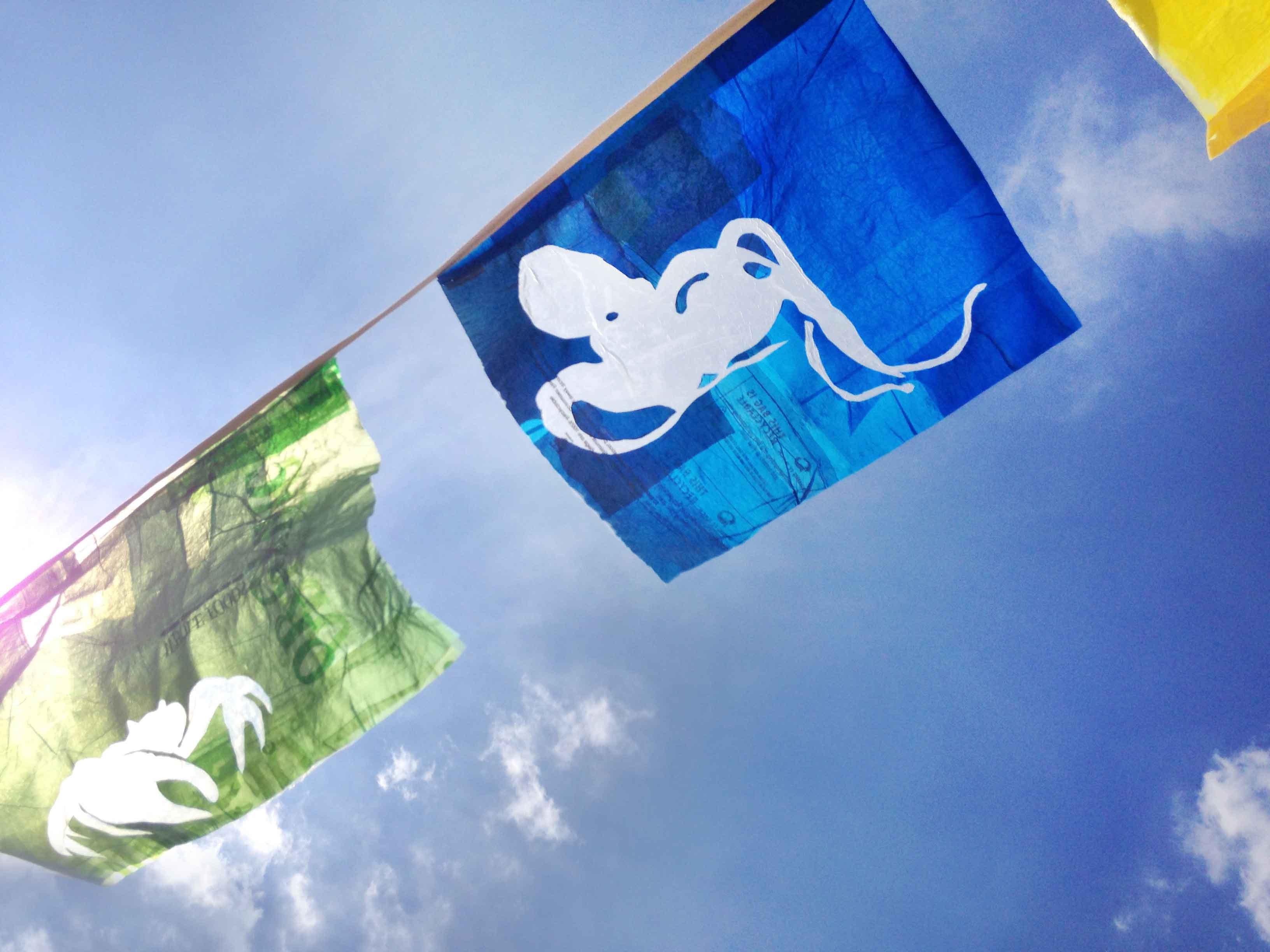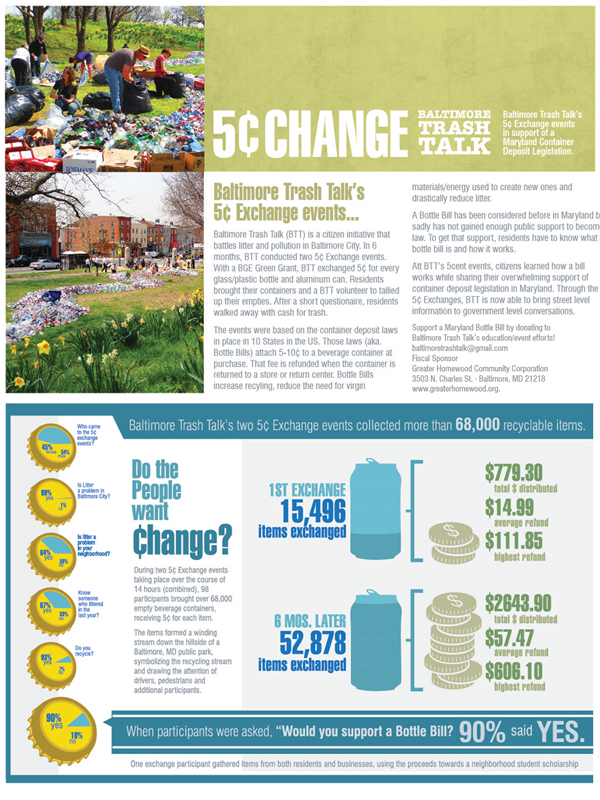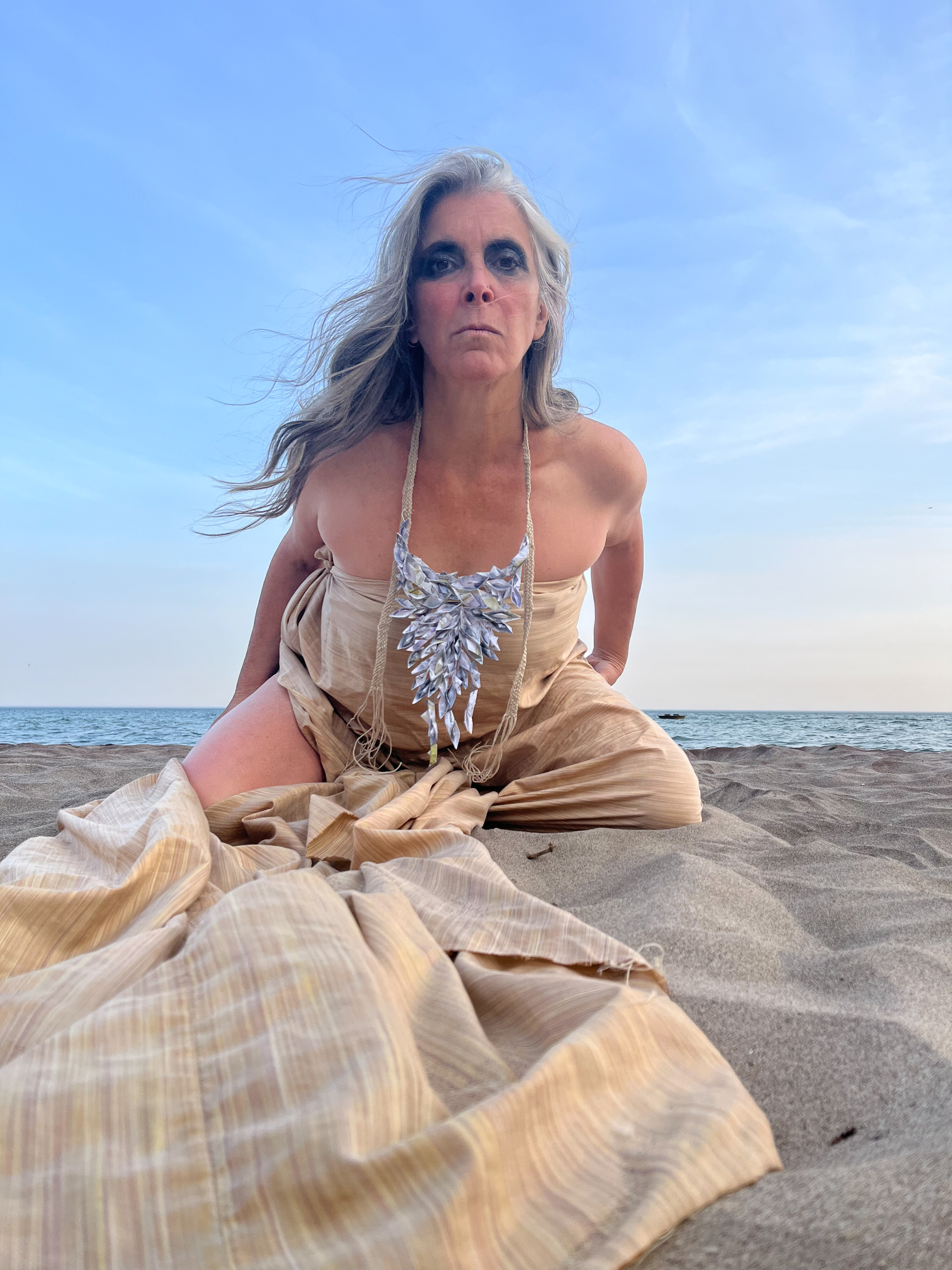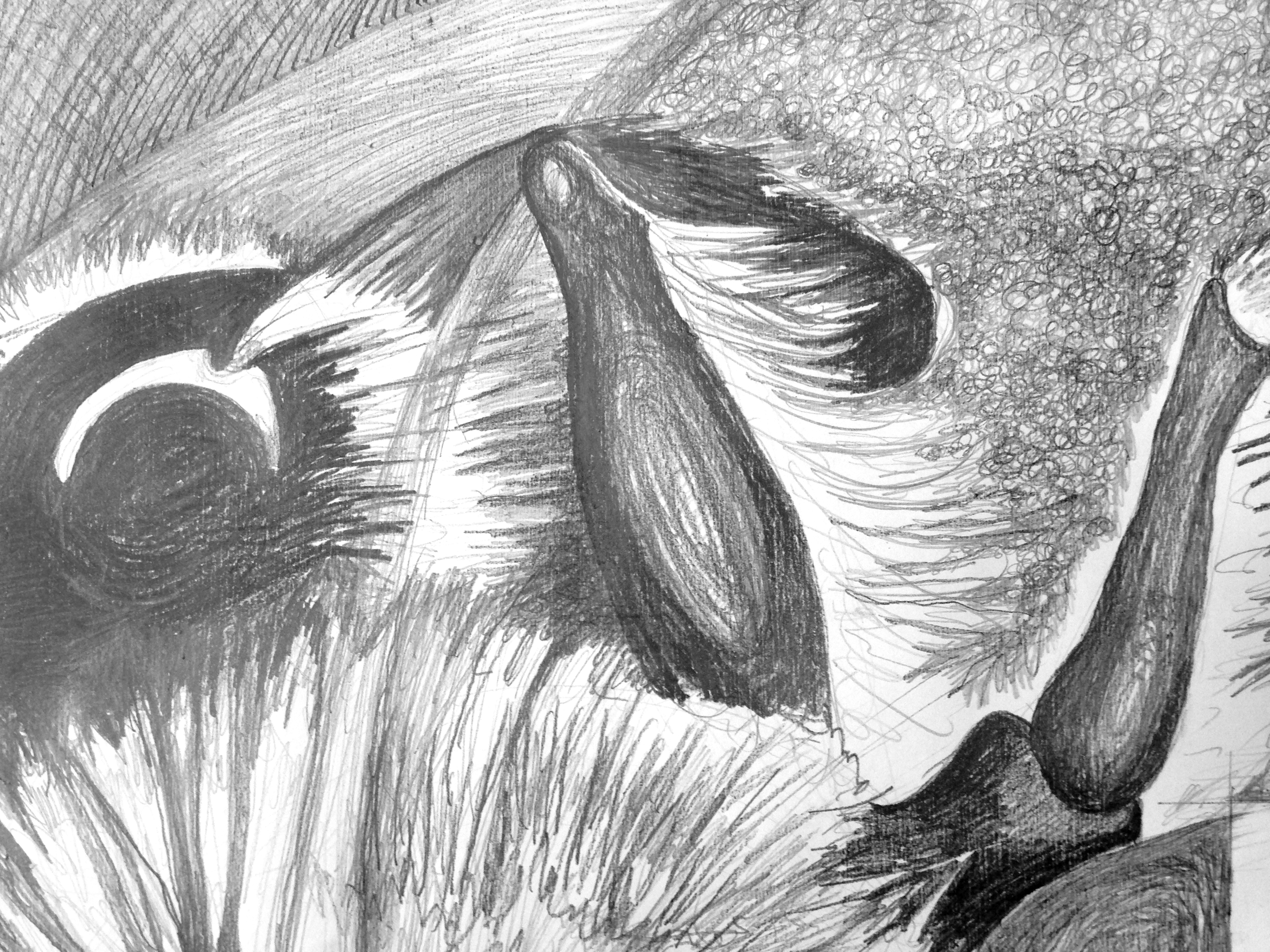About Bridget

Bridget Parlato is a designer/artist/activist based in urban southeast Baltimore, MD. She runs Full Circuit Studio as a freelance designer specializing in cause-related work. She also heads up Baltimore Trash Talk, an anti-trash activism initiative that works towards raising awareness and seeking behavioral change through digital and print campaigns, sculptures, public events, performances, installations and school outreach.
Apart from her graphic portfolio, Parlato’s personal work… more
Baltimore Trash Talk - Intstallations and Public Work
These installations and artworks have served to raise awareness of how much we litter, of our consumption of one-use/plastic items and our need for legislation and education regarding these issues.
Two of the Rivers of Recycling were advertised by myself and executed with the help of family, friends and volunteers. The data collected was used to testify in front of policy makers Annapolis in support of Bottle Deposit Legislation (take your bottle back to a store, get 5 cents back per bottle).
Prayers for the Sea/ River of Recycling was installed at Artscape. A series of 100 18" flags in the fashion of Tibetan Prayer Flags were created from fused plastic bags and flown above the river. The River was executed with the help of Clean Corps and BOPA volunteers.
The River was again recreated at Johns Hopkins University as part of a thesis exhibition for MICA curatorial grad, Christopher Beer (See project pictures for further details/description).
Other projects include flash trash creations during the trash wheel trash count and community storm drain stenciling.
-
 Prayers for the Sea - River of Recycling at ArtscapePrayers for the Sea Flags - Created for the River of Recyclables at Artscape 2015 - which focused on a water theme. They were part of a show called Harbor High Port (of call) and other Phenomenades curated by Laure Drogoul. 100 flags influenced by Tibetan Prayer Flags were created to fly above the river. The flags were comprised of fused plastic bags and had images of sea creatures cut into them or fused onto them. Plastic bags are one of the most littered items found on both land and in the oceans. The Artscape River of Recyclables was comprised of bottles and cans collected from 10 recycling bins placed by Baltimore Trash Talk as well as from trash cans at the event. The piece was accompanied by Baltimore Trash Talk posters shown on the Charles Street LED billboard in the near distance.
Prayers for the Sea - River of Recycling at ArtscapePrayers for the Sea Flags - Created for the River of Recyclables at Artscape 2015 - which focused on a water theme. They were part of a show called Harbor High Port (of call) and other Phenomenades curated by Laure Drogoul. 100 flags influenced by Tibetan Prayer Flags were created to fly above the river. The flags were comprised of fused plastic bags and had images of sea creatures cut into them or fused onto them. Plastic bags are one of the most littered items found on both land and in the oceans. The Artscape River of Recyclables was comprised of bottles and cans collected from 10 recycling bins placed by Baltimore Trash Talk as well as from trash cans at the event. The piece was accompanied by Baltimore Trash Talk posters shown on the Charles Street LED billboard in the near distance. -
 Prayers for the Sea - River of Recycling at Artscape -Aerial ViewThis River of Recyclables was established at Artscape 2015 - which focused on a water theme. It was part of a show called Harbor High Port (of call) and other Phenomenades curated by Laure Drogoul. This piece was comprised of bottles and cans collected from 10 recycling bins placed by Baltimore Trash Talk as well as from trash cans at the event. 100 flags influenced by Tibetan Prayer Flags were created to fly above the river. The flags were comprised of fused plastic bags and had images of sea creatures cut into them or fused onto them. Plastic bags are one of the most littered items found on both land and in the oceans. The piece was accompanied by Baltimore Trash Talk posters shown on the Charles Street LED billboard in the near distance.
Prayers for the Sea - River of Recycling at Artscape -Aerial ViewThis River of Recyclables was established at Artscape 2015 - which focused on a water theme. It was part of a show called Harbor High Port (of call) and other Phenomenades curated by Laure Drogoul. This piece was comprised of bottles and cans collected from 10 recycling bins placed by Baltimore Trash Talk as well as from trash cans at the event. 100 flags influenced by Tibetan Prayer Flags were created to fly above the river. The flags were comprised of fused plastic bags and had images of sea creatures cut into them or fused onto them. Plastic bags are one of the most littered items found on both land and in the oceans. The piece was accompanied by Baltimore Trash Talk posters shown on the Charles Street LED billboard in the near distance. -
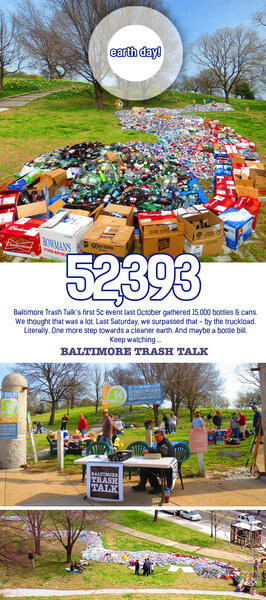 River of Recyclables - Email about 5 cent Bottle Return eventEmail showing pictures and results of the second 5¢ bottle and can return event. This event was 6 months after the first event and the total number of items returned more than tripled from 15K to 52K+. The first two river events were funded by BGE through a grant. I applied for the grant, planned the event, designed marketing materials for it and marketed it. I ran the event, enlisting the volunteer help of friends and family. The events were based on the container deposit laws in place in 10 States in the US. Those laws (aka. Bottle Bills) attach 5-10¢ to a beverage container at purchase. That fee is refunded when the container is returned to a store or return center. Bottle Bills increase recyling, reduce the need for virgin materials/energy used to create new ones and drastically reduce litter.
River of Recyclables - Email about 5 cent Bottle Return eventEmail showing pictures and results of the second 5¢ bottle and can return event. This event was 6 months after the first event and the total number of items returned more than tripled from 15K to 52K+. The first two river events were funded by BGE through a grant. I applied for the grant, planned the event, designed marketing materials for it and marketed it. I ran the event, enlisting the volunteer help of friends and family. The events were based on the container deposit laws in place in 10 States in the US. Those laws (aka. Bottle Bills) attach 5-10¢ to a beverage container at purchase. That fee is refunded when the container is returned to a store or return center. Bottle Bills increase recyling, reduce the need for virgin materials/energy used to create new ones and drastically reduce litter. -
Baltimore Trash Talk Artscape - River of Recyclables / Prayers for the Sea - Installation 1This River of Recyclables was established at Artscape 2015 - which focused on a water theme. It was part of a show called Harbor High Port (of call) and other Phenomenades curated by Laure Drogoul. This piece was comprised of bottles and cans collected from 10 recycling bins placed by Baltimore Trash Talk as well as from trash cans at the event. 100 flags influenced by Tibetan Prayer Flags were created to fly above the river. The flags were comprised of fused plastic bags and had images of sea creatures cut into them or fused onto them. Plastic bags are one of the most littered items found on both land and in the oceans. The piece was accompanied by Baltimore Trash Talk posters shown on the Charles Street LED billboard in the near distance.
-
 River of Recyclables - Flyer of Can Return DataThis is a flyer/infographic used as testimony/data in support of Bottle Bill legislation before the House and Senate in Annapolis. The events were funded by BGE and based on the container deposit laws in place in 10 States in the US. Those laws (aka. Bottle Bills) attach 5-10¢ to a beverage container at purchase. That fee is refunded when the container is returned to a store or return center. Bottle Bills increase recyling, reduce the need for virgin materials/energy used to create new ones and drastically reduce litter. Each person's bottles were counted, recorded, and used to create the above infographic.
River of Recyclables - Flyer of Can Return DataThis is a flyer/infographic used as testimony/data in support of Bottle Bill legislation before the House and Senate in Annapolis. The events were funded by BGE and based on the container deposit laws in place in 10 States in the US. Those laws (aka. Bottle Bills) attach 5-10¢ to a beverage container at purchase. That fee is refunded when the container is returned to a store or return center. Bottle Bills increase recyling, reduce the need for virgin materials/energy used to create new ones and drastically reduce litter. Each person's bottles were counted, recorded, and used to create the above infographic.
Once Upon Water - Residency, Toronto
In May of 2023, I had the honor of being one of 14 international recipients of a 2 week residency entitled "Once Upon Water" at the Gibraltar Point Center for the Arts on Toronto Island in Canada. All artists were required to bring the theme of water into their creations.
I was accepted as a writer and explored water through poetry, photography, self-portraits and jewelry.
-
 Once Upon Water - Mayday Necklace
Once Upon Water - Mayday NecklaceOnce Upon Water - Mayday Necklace
-
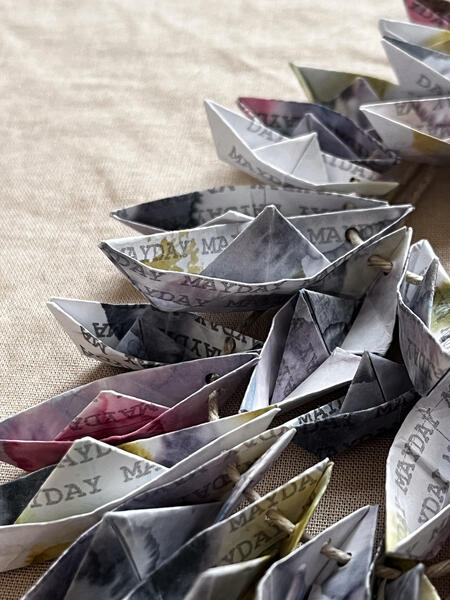 Mayday /The Precariousness of Our Predicament- a neckpiece of weathered paper boats imprinted with the repeated message, "Mayday".
Mayday /The Precariousness of Our Predicament- a neckpiece of weathered paper boats imprinted with the repeated message, "Mayday".Mayday /The Precariousness of Our Predicament- a neckpiece of weathered paper boats imprinted with the repeated message, "Mayday".
-
 Mayday / Waterspirit #1
Mayday / Waterspirit #1Mayday / Waterspirit #1
-
 Mayday / Waterspirit #1
Mayday / Waterspirit #1Mayday / Waterspirit #1
Pollinators and Neonicotinoids
Neonicotinoids are a class of insecticides chemically related to nicotine that act on receptors in the nerve synapse. They are toxic to insects, mammals, birds and other higher organisms. Marketed by European chemical giants Syngenta and Bayer, neonics are the most widely used insecticides both in the United States and globally. In a report released a year ago, the EPA basically conceded the case that these pesticides harm bees and other pollinators. They still remain on the market.
-
Parlato Pollinator Bird and Neonicotinoid Detail.JPGDrawing of a dead bird and a Neonicotinoid molecule. Neonicotinoids are a class of insecticides chemically related to nicotine that act on receptors in the nerve synapse. They are toxic to insects, mammals, birds and other higher organisms. Marketed by European chemical giants Syngenta and Bayer, neonics are the most widely used insecticides both in the United States and globally. In a report released a year ago, the EPA basically conceded the case that these pesticides harm bees and other pollinators. They still remain on the market.
-
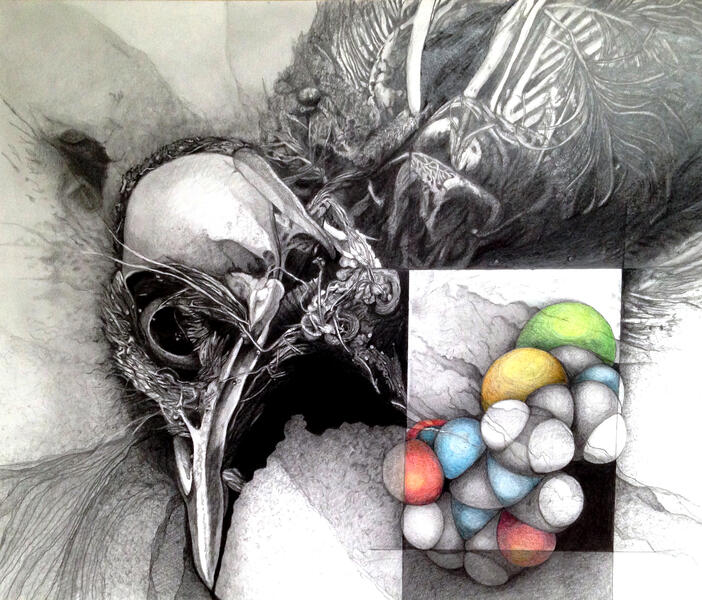 Dead Bird and Neonicotinoid MoleculeDead Bird and Neonicotinoid Molecule
Dead Bird and Neonicotinoid MoleculeDead Bird and Neonicotinoid Molecule -
Parlato Pollinator Bird Feet and Neonicotinoid.JPGDrawing of a dead birdand a Neonicotinoid molecule. Neonicotinoids are a class of insecticides chemically related to nicotine that act on receptors in the nerve synapse. They are toxic to insects, mammals, birds and other higher organisms. Marketed by European chemical giants Syngenta and Bayer, neonics are the most widely used insecticides both in the United States and globally. In a report released a year ago, the EPA basically conceded the case that these pesticides harm bees and other pollinators. They still remain on the market.
-
Parlato Pollinator - Bird Feet DetailDetail - Drawing of a dead bird and a Neonicotinoid molecule. Neonicotinoids are a class of insecticides chemically related to nicotine that act on receptors in the nerve synapse. They are toxic to insects, mammals, birds and other higher organisms. Marketed by European chemical giants Syngenta and Bayer, neonics are the most widely used insecticides both in the United States and globally. In a report released a year ago, the EPA basically conceded the case that these pesticides harm bees and other pollinators. They still remain on the market.
-
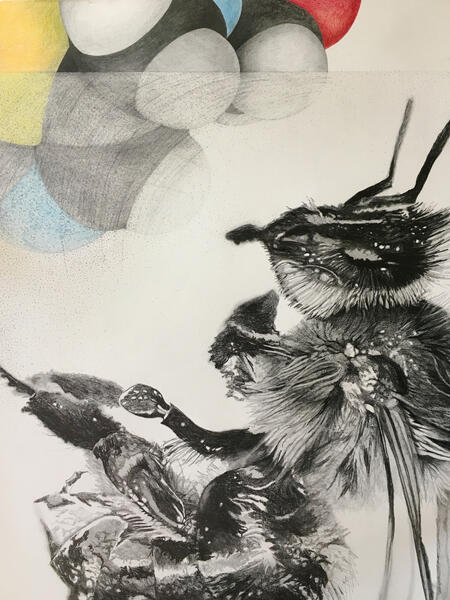 Bee Drawing (In Progress)Drawing of a dead bee and a Neonicotinoid molecule. Neonicotinoids are a class of insecticides chemically related to nicotine that act on receptors in the nerve synapse. They are toxic to insects, mammals, birds and other higher organisms. Marketed by European chemical giants Syngenta and Bayer, neonics are the most widely used insecticides both in the United States and globally. In a report released a year ago, the EPA basically conceded the case that these pesticides harm bees and other pollinators. They still remain on the market.
Bee Drawing (In Progress)Drawing of a dead bee and a Neonicotinoid molecule. Neonicotinoids are a class of insecticides chemically related to nicotine that act on receptors in the nerve synapse. They are toxic to insects, mammals, birds and other higher organisms. Marketed by European chemical giants Syngenta and Bayer, neonics are the most widely used insecticides both in the United States and globally. In a report released a year ago, the EPA basically conceded the case that these pesticides harm bees and other pollinators. They still remain on the market. -
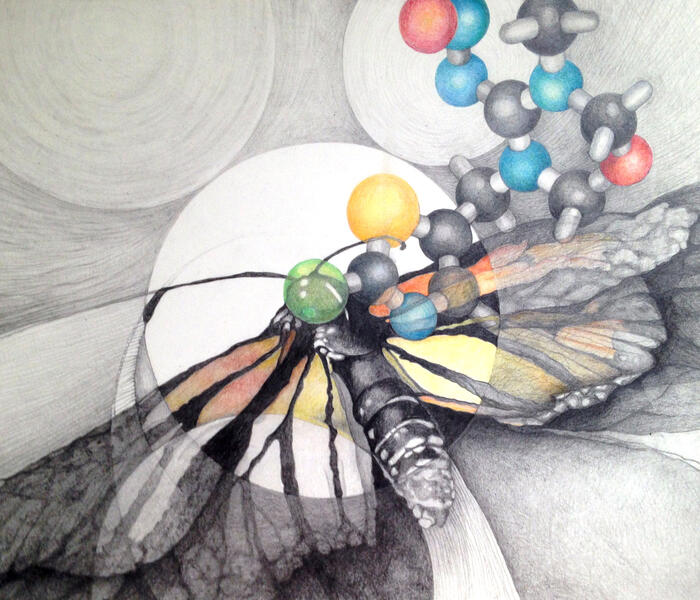 Parlato Pollinator bird 2.jpgDrawing of a dead bird and a Neonicotinoid molecule. Neonicotinoids are a class of insecticides chemically related to nicotine that act on receptors in the nerve synapse. They are toxic to insects, mammals, birds and other higher organisms. Marketed by European chemical giants Syngenta and Bayer, neonics are the most widely used insecticides both in the United States and globally. In a report released a year ago, the EPA basically conceded the case that these pesticides harm bees and other pollinators. They still remain on the market.
Parlato Pollinator bird 2.jpgDrawing of a dead bird and a Neonicotinoid molecule. Neonicotinoids are a class of insecticides chemically related to nicotine that act on receptors in the nerve synapse. They are toxic to insects, mammals, birds and other higher organisms. Marketed by European chemical giants Syngenta and Bayer, neonics are the most widely used insecticides both in the United States and globally. In a report released a year ago, the EPA basically conceded the case that these pesticides harm bees and other pollinators. They still remain on the market. -
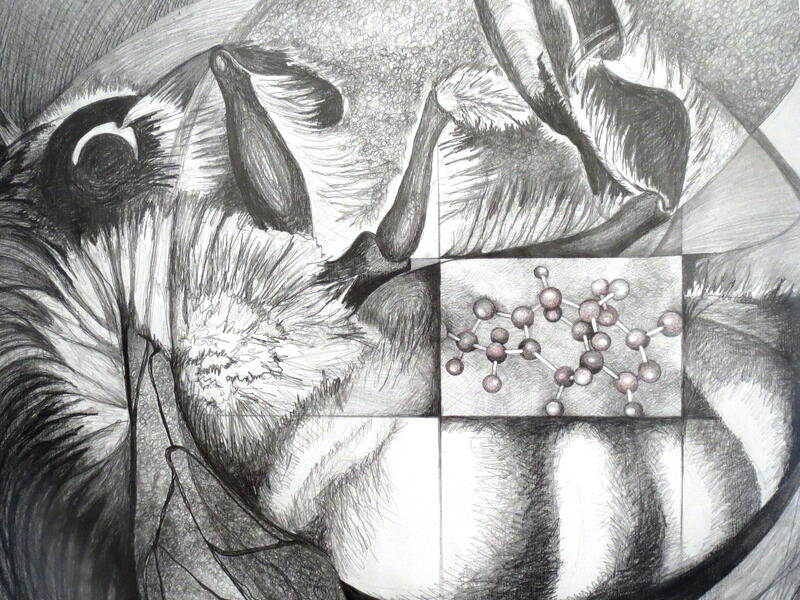 Parlato Pollinator Bee and Neonicotinoid.jpgDrawing of a dead bee and a Neonicotinoid molecule. Neonicotinoids are a class of insecticides chemically related to nicotine that act on receptors in the nerve synapse. They are toxic to insects, mammals, birds and other higher organisms. Marketed by European chemical giants Syngenta and Bayer, neonics are the most widely used insecticides both in the United States and globally. In a report released a year ago, the EPA basically conceded the case that these pesticides harm bees and other pollinators. They still remain on the market.
Parlato Pollinator Bee and Neonicotinoid.jpgDrawing of a dead bee and a Neonicotinoid molecule. Neonicotinoids are a class of insecticides chemically related to nicotine that act on receptors in the nerve synapse. They are toxic to insects, mammals, birds and other higher organisms. Marketed by European chemical giants Syngenta and Bayer, neonics are the most widely used insecticides both in the United States and globally. In a report released a year ago, the EPA basically conceded the case that these pesticides harm bees and other pollinators. They still remain on the market. -
 Parlato Pollinator Bee and Neonicotinoid Detail.jpgDrawing of a dead bee and a Neonicotinoid molecule. Neonicotinoids are a class of insecticides chemically related to nicotine that act on receptors in the nerve synapse. They are toxic to insects, mammals, birds and other higher organisms. Marketed by European chemical giants Syngenta and Bayer, neonics are the most widely used insecticides both in the United States and globally. In a report released a year ago, the EPA basically conceded the case that these pesticides harm bees and other pollinators. They still remain on the market.
Parlato Pollinator Bee and Neonicotinoid Detail.jpgDrawing of a dead bee and a Neonicotinoid molecule. Neonicotinoids are a class of insecticides chemically related to nicotine that act on receptors in the nerve synapse. They are toxic to insects, mammals, birds and other higher organisms. Marketed by European chemical giants Syngenta and Bayer, neonics are the most widely used insecticides both in the United States and globally. In a report released a year ago, the EPA basically conceded the case that these pesticides harm bees and other pollinators. They still remain on the market. -
Dead Bees and Neonicotinoid Molecule (In Progress)Drawing of a dead bee and a Neonicotinoid molecule. Neonicotinoids are a class of insecticides chemically related to nicotine that act on receptors in the nerve synapse. They are toxic to insects, mammals, birds and other higher organisms. Marketed by European chemical giants Syngenta and Bayer, neonics are the most widely used insecticides both in the United States and globally. In a report released a year ago, the EPA basically conceded the case that these pesticides harm bees and other pollinators. They still remain on the market.
